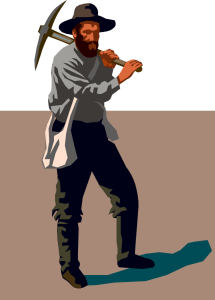 It’s a real rush to pass on a tip from Lawrence Block because he just might be the most major monster in crime fiction. Consider: he’s author of over forty novels (and that’s just under his own name — not counting another 50 or so under various noms du travail). But it goes way beyond that. He’s one of those writers that everybody in his field has read, and most other writers in that field have been influenced by. His Matt Scudder series is an uber-classic, a modern version of Chandler or Hammett. But with a more human character arc, readers watched Scudder come to grips with his alcoholism. Scudder alone would enshrine Mr. Block in the Crime Hall of Fame… Continue reading “Tips from the Masters: Lawrence Block”
It’s a real rush to pass on a tip from Lawrence Block because he just might be the most major monster in crime fiction. Consider: he’s author of over forty novels (and that’s just under his own name — not counting another 50 or so under various noms du travail). But it goes way beyond that. He’s one of those writers that everybody in his field has read, and most other writers in that field have been influenced by. His Matt Scudder series is an uber-classic, a modern version of Chandler or Hammett. But with a more human character arc, readers watched Scudder come to grips with his alcoholism. Scudder alone would enshrine Mr. Block in the Crime Hall of Fame… Continue reading “Tips from the Masters: Lawrence Block”
Author: Lin Robinson
Side Order of Kick: The Wind Beneath the Wingman

The lowly sidekick, treated properly and bought a beer now and then, can be utilized as a very powerful writing trope or crutch or supercharger.
I’m not talking about the usual wingman, here, like Robin, Kato, Jimmy Olson, Chewbacca, or Tonto. Or comic relief roles like Tarzan’s Cheetah or Wild Bill’s Jingles. I’m talking about a second character that enables and expands the lead, becomes a necessary part or subset of the hero and allows or forces him to be more and do more.
It goes beyond even an essential, defining companion like Holmes’ Dr. Watson, who, don’t forget, is the first-person narrator of the Sherlock stories and extremely important to the narrative voice and shape of those books. Because there are possibilities deeper than that, which can possibly be of use in solving problems beyond the construction of your main character or the constellation of the principle figures, but the actual form and procedure of your story. Continue reading “Side Order of Kick: The Wind Beneath the Wingman”
After the Gold Rush
 I was talking with another author, DV Berkom, yesterday about indie publishing. Both of us wrote as staff of Indies Unlimited and both of us agreed on a major reality of self/indie publishing.
I was talking with another author, DV Berkom, yesterday about indie publishing. Both of us wrote as staff of Indies Unlimited and both of us agreed on a major reality of self/indie publishing.
Namely, that there was a “Golden Age” when everything came together at once and it was a virgin New World ripe for the taking… but that’s changed.
A lot of the people whose advice we take on publishing–largely because we see their big successes as meaning they know what we should do–were very encouraging because of those successes, but it’s important to realize that the environment in which they achieved them is no longer the same. Some might even say, no longer exists. Continue reading “After the Gold Rush”
You Don’t Need a Tragic Flaw, Just the Wrong Woman
 Any time you are having trouble structuring your story’s plot and look for advice… God help you. It’s a heaving sea of templates and graphs and step-ins and theories and jargon, and many run to book length. Some, like “Hero’s Journey” verge on being religions.
Any time you are having trouble structuring your story’s plot and look for advice… God help you. It’s a heaving sea of templates and graphs and step-ins and theories and jargon, and many run to book length. Some, like “Hero’s Journey” verge on being religions.
I would suggest that you look for the simplest, most powerful skeleton key you can find. And I’ll be a little more directive; I think it might be this video by Michael Arndt, who wrote Toy Story 3 for Pixar. Yes, it’s about screenwriting. Yes, it deals only with the first act… but the principles are valid in any story, and once your first act is nailed down, you’re on your way. See it here: http://nofilmschool.com/2014/04/get-your-first-act-written-pixars-michael-arndt-shows-how-video/
An even simpler, and very time-tested, principle that cuts you to the chase is the concept of “tragic flaw”. Remember that from reading Hamlet and Macbeth and Sophocles? Anybody will tell you that your hero or protagonist or MC or whatever you want to call them doesn’t absolutely have to have a “tragic flaw”. But it sure does make it easier.
As Arndt says, faced with trouble, he can take the moral high road or the low road of his own weakness…and if he takes the high road you don’t have a story. Another term for “taking the low road” is “tragic flaw”.
But there is another way to set that mechanism up without there being anything wrong with your main guy. You don’t need a flawed main man—just hook him up with a woman who’s no good for him and let her do him wrong. My best-reviewed and most popular novel is “Sweet Spot”, featuring baseball star turned Mazatlan political journalist Mundo Carrasco. He’s a character that both men and woman alike find pleasant: he’s a main thing that’s made that book sell. But there is nothing really wrong with him. What he has, to generate conflict and dip him in the soup, is an obsession with a woman. And she is a femme most definitely fatale, no question in your mind that he should get the hell away from her. But what’s a guy going to do when he’s being led by the leading portion of his anatomy? He’s infatuated. That’s a real key to the appeal of that book: chicks dig the idea of a guy who’s so gone on a woman that he’ll follow her right down the tubes. Continue reading “You Don’t Need a Tragic Flaw, Just the Wrong Woman”
